TASK – 1 1 Different types, size and scope of organizations
21 Pages5590 Words90 Views
Added on 2020-12-10
TASK – 1 1 Different types, size and scope of organizations
Added on 2020-12-10
ShareRelated Documents
BUSINESS AND THE BUSINESSENVIRONMENT
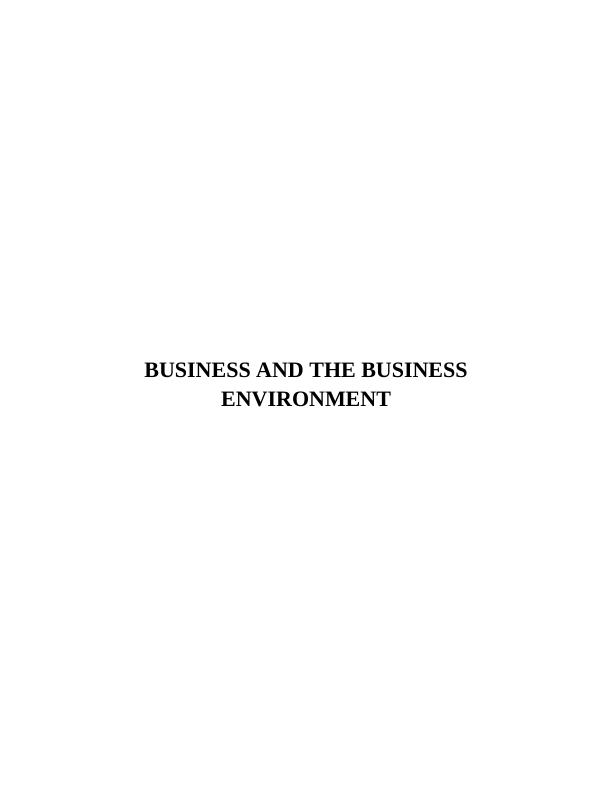
CONTENTSINTRODUCTION.......................................................................................................................................1TASK – 1....................................................................................................................................................1Different types, size and scope of organizations......................................................................................1TASK – 2....................................................................................................................................................3Definition of Organization structure........................................................................................................3Two types of organizational structure......................................................................................................4Relationship with other functions............................................................................................................6TASK – 3....................................................................................................................................................7PESTEL analysis.....................................................................................................................................7TASK – 4..................................................................................................................................................10SWOT analysis......................................................................................................................................10Inter-relation of Strength and Weakness with Macro and Micro factors in business decisions..............11REFERENCES..........................................................................................................................................13
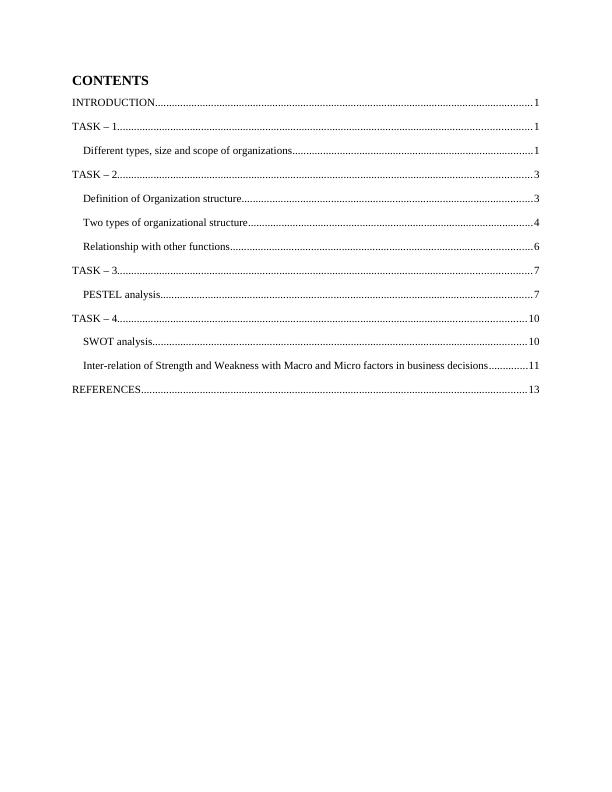

INTRODUCTION Focusing towards business environment, the concept is quite wide encompassing factorsthat are internal and external to the business significantly impacts the working and functioning ofthe organization. Firms operate in the environment which has two distinct sub-parts i.e. microand macro. Both these environments are inter-related with each other and their influences on thefunctioning of the business are based upon the type of the firms (Daft, 2007). Therefore, it isnecessary to evaluate the environment for the purpose of fostering easy flow of activities. Thecurrent research is also concerned towards analyzing varied types, scope, size, structure ofbusiness organizations. For this purpose, case study of JP Morgan Finance and Investment isbeing taken into consideration. It is one of the UK’s leading investment company commercial,industrial and market financial banking and services. As a Client Manager of JP Morgan, varioustypes of companies will be analyzed as a client of the firm. The report will also throw light oninter-relationship between varied functions and will demonstrate the influence of macro-environmental factors on the business operations. The later part of the report will focus onidentifying the internal strength and weaknesses of JP Morgan and will explain their inter-relationship as well. TASK – 1Different types, size and scope of organizationsTalking in reference with organization, it is defined as an entity which encompassesmultiple people like association or institution and has a common goal along with a link to theexternal environment. In other words, two or more people combines and work together toachieve a common interest. Further, it is very important that firms should be formed with somepurpose, as it serves as guide to the business and it is the main root for many other types ofdecisions (Brooks, 2003). The main purpose of each and every organization is to achieve theirmission, vision and goals being decided and indicated at the time when the firm is formed.However, it surely varies with the types of firms but on a whole there main aim is to renderservices to their clients along with achieving their own growth with the passage of time. In aneconomy of a nation, there are three main sectors i.e. primary, secondary and tertiary sectors. Inthe primary sector most of the people are employed in agriculture and production of food. The1
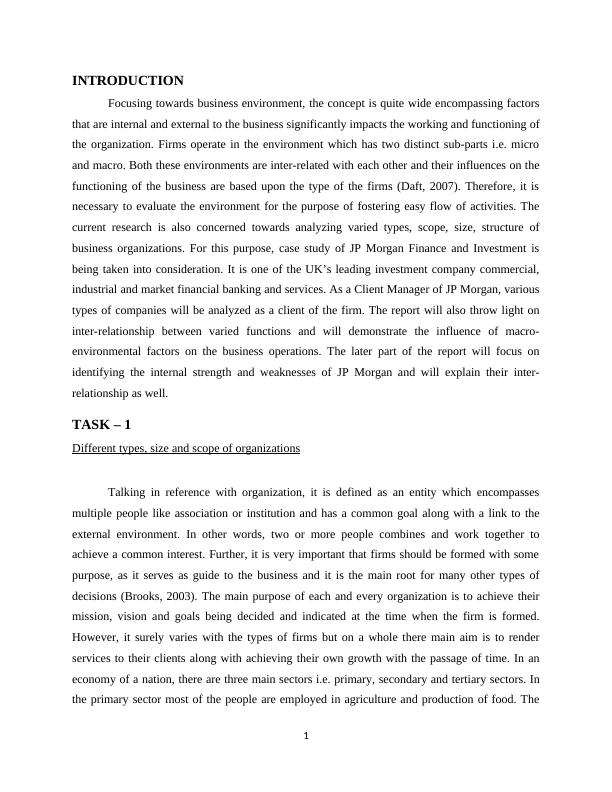
secondary sector is mainly related with offering finished goods like clothes, toys, factories andfood. Tertiary sector is mainly concerned with providing intangible products and services to thecustomers such as banking, tourism, retail and IT services. Throwing light on the economy ofUK, it is highly developed as well as market oriented (Pettinger, 2017). In UK, tertiary sector hasa major dominance in the economy. However, primary and secondary sector too exists but theycomprise only 20-40 percent in the total size of the sectors. The classification of different typesof organizations is being described underneath:Sole trader – It is being defined as a business which is being owned by on person and hasfull control over the business. One of the major advantages of this type of firm is that theprofits from the business are retained by the sole trader. Further, decisions are takenquickly, as he is only person liable to make decisions and plans. However, Sole tradersare not seen as a separate entity and thus, they are subject to unlimited liability. Itbecomes also difficult for them to raise finance as well. For example, a doctor ispracticing home healthcare (Heinz and Koontz, 2010). He is the sole trader of hisbusiness and belongs to the tertiary sector, as he is offering intangible services to thecustomers. Partnership – In partnership, two or more person combines and works together forachieving common interest and goals. One major benefit of partnership is that there willbe availability of more capital and there are also limited external regulations. However, itinvolves high risk of disagreements and each and every partner is liable for actions ofother partners. For example, in a restaurant business, two or more people combinestogether and make investment. This industry belongs to the secondary sector as they areusing raw-materials from primary sector and manufacturing the products (Robbins andCoulter, 2002). Limited company – Speaking about the limited companies, it is being defined as a type ofa business structure that enjoys limited liabilities and is being owned by shareholders andguarantors and managed by the owners. It has a separate legal entity from the owners.Furthermore, even the finances of the business are separate from the owner’s personalfinances. One of the major benefits of limited company is that it has limited liabilities andfinancial security. Moreover, it has separate legal entity. On the other hand, it involves2
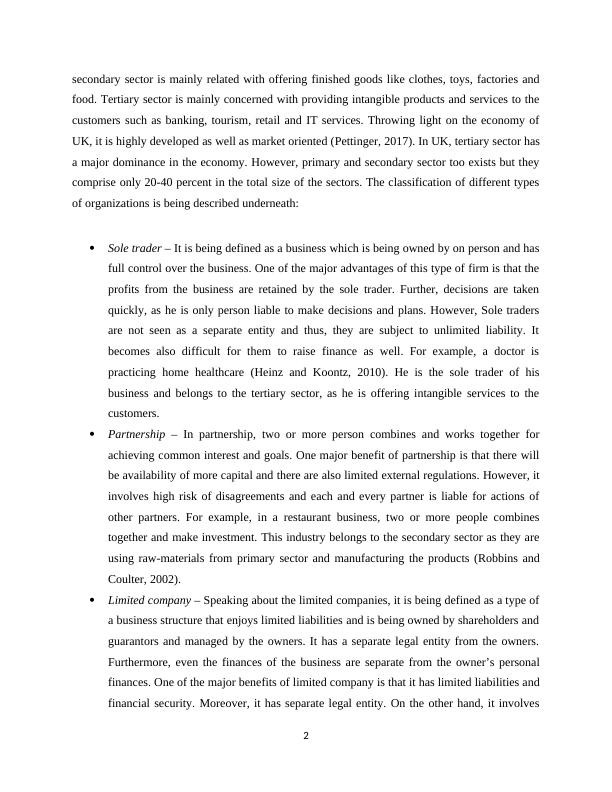
complex as well as restrictive rules related to accounts and book-keeping. Warburton’s abaking firm of UK is a perfect example of limited company which belong to secondarysector (Huczynski and Buchanan, 2000). Public Limited company – It is a legal designation of a limited liability company whichhas offered their shares to the general public and enjoys limited amount of liability. Thestock is offered to the general public and can be acquired by anyone privately, at the timeof initial public offer or through trades on stock. The finances of the public limitedcompanies are separate from the personal finances of their members. They must have twoor more shareholders, must have issues their shares in public, registered at CompaniesHouse and must have at least two directors. The ability to raise capital by issuing publicshares in one of the biggest advantages of public limited companies. In addition to this,there is big potential for growth (Aidan, 2016). However, there more regulations involvedand it demands high transparency in terms of accounting. For example, Rolls-Royce is apublic limited company and falls under the secondary sector of the economy. Government and Charity – Government and charity organizations have a sole aim tosupport and help the general public. These are voluntary organizations or associationsbeing formed by the collaboration of two or more people. The main purpose of thesefirms is to serve the community by employing their best efforts. For example, NationalChild Birth Trust (NCT) is one of the leading UK based charity. These types of firms fallin the tertiary sector, as they are offering services to people which are intangible in nature(Wren and Bedeian, 2009). Thus, to conclude it can be said that there are many types of organization and each ofthem has different purposes, advantage and disadvantages according to the type of business theyare engaged in. except the sole trader, all have one thing in common that they are being formedby the association of two or more people. Further, the risk involved in the business varies withtheir size and scope of business. TASK – 2Definition of Organization structure Articulating in relation with the organizational structure, it is being defined as a way ofarranging people and their jobs in order to accomplish the work task as well as to achieve pre-3
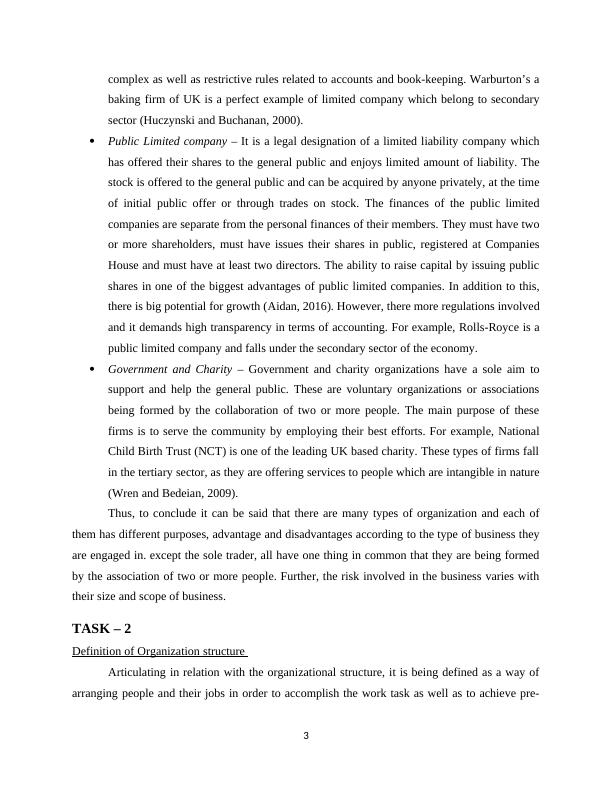
End of preview
Want to access all the pages? Upload your documents or become a member.
Related Documents
Business and The Business Environment Solved Assignment (Doc)lg...
|18
|5276
|85
Business and Business Environment Report - Tescolg...
|18
|4913
|30
The Impact of Macro-environmental Factors on JP Morgan's Business Operationslg...
|18
|5166
|491
Business and Business Environment Assignment - JP Morgan Finance and Investment companylg...
|18
|4992
|200
Purposes of Business and The Business Environment.lg...
|16
|4471
|314
Business & the Business Environment - Sainsburylg...
|15
|4156
|494
